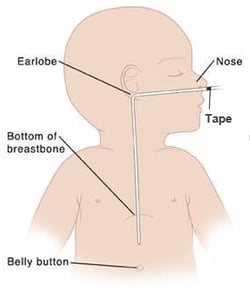What is a Nasogastric (NG) feeding tube?
- It is a thin, soft tube that goes in your baby’s nose and down the throat (esophagus) into the stomach. NG tubes are used to give nutrition or medicine to your baby.
- You may learn how to put in the tube so that you can change it at home if needed.
- The doctor or nurse will tell you if you need to learn how to put the tube in your baby. They will also tell you how often you should change the NG tube.
When is the best time to change the tube?
- Choose a time before feeding or giving medicine to put in the NG tube.
- Your baby’s stomach should be nearly empty.
- This will help keep your baby from throwing up when the tube is put in.
What supplies are needed?
If the NG tube is not broken when you change it, you can use it again, if needed.
You must wash the NG tube well with warm water and soap before re-using it.
- NG tube.
- ½ inch tape, cut 2 pieces.
- Water soluble lubricant. This will be given to you by the home care agency.
- Small syringe (5 to 10 mL).
- Measuring tape.
How is the NG tube put in?
It may be easier or needed to get a second person to help.
1. Get your supplies.
2. Attach the syringe to the end of the NG tube.
3. Wash your hands for at least 20 seconds with warm water and soap.
4. Use a different nostril each time you put in the NG tube.
5. Lay your baby in a crib or bed. If it is safe, recline your baby in an infant seat. You may need a second person to help hold your baby.
- turns blue
- gasps or cries without sound at any time while putting in the NG tube pull it out! Stop and give your baby a rest. Then Try again.
6. Measure the tube.
- Lay the tube on top of your baby to measure it before you put it in their nose.
- Place the tip of the tube on the stomach between the belly button and the lower rib cage. Hold it there.
- Bring the tube up to your baby’s ear lobe, then out to the nose.
- Mark the NG tube with a piece of tape at the tip of the nose.
7. Put the tube in.
- Have your baby suck on a pacifier while you are putting in the NG tube. This may help it go in.
- Dip the tip of the NG tube in water soluble lubricant to wet the tube.
- Put the tip of the tube in one nostril and gently push it to the back of the throat.
- Quickly push the NG tube in until the piece of tape is touching the nose (nare). Do not force.
- Tape the NG tube to your baby’s cheek. To help keep the NG from being pulled out by accident, you may loop the NG tube and tape it behind the ear or to clothing
- Measure how long from the nose to the end of the tube. Write this measurement down.
How will I know the NG is in the stomach?
Be sure to check that the tube is in the right place in the stomach each time you put it in, before each feeding, or before giving medicine.
To check where the NG tube is placed:
1. Look to see if the tape marking the tube is still close to the nostril.
2. Measure outer portion of NG tube (from the nose to end of tube). Compare this measurement with previous measurements. It is okay to use the NG tube if the difference in measurements is less than 2 centimeters and your baby tolerates the feedings without choking or gagging.
3. Attach the syringe to the end of the NG tube.
4. Pull back the plunger on the syringe and look for stomach contents in the tube or syringe.
- Stomach contents may look grassy green, light yellow (may be almost clear), brown, like formula, or have small pieces of food.
- If you get stomach contents, the NG tube is in.
- You may not always get stomach contents even through the tube is in.
You may push a small amount of air through the tube and try a second time to pull back and check for stomach contents.
5. If you are not sure the tube is in the stomach, take it out and put it in again.
Are there any complications with the NG tube?
Your baby may:
- Throw up.
- Have nasal congestion.
- Cough a lot.
- Have an increase in bowel movements.
- Choke.
- Be very crabby.
- Make a gurgling sound when they breathe.
If any of these happen, remove the NG tube and call your doctor.



